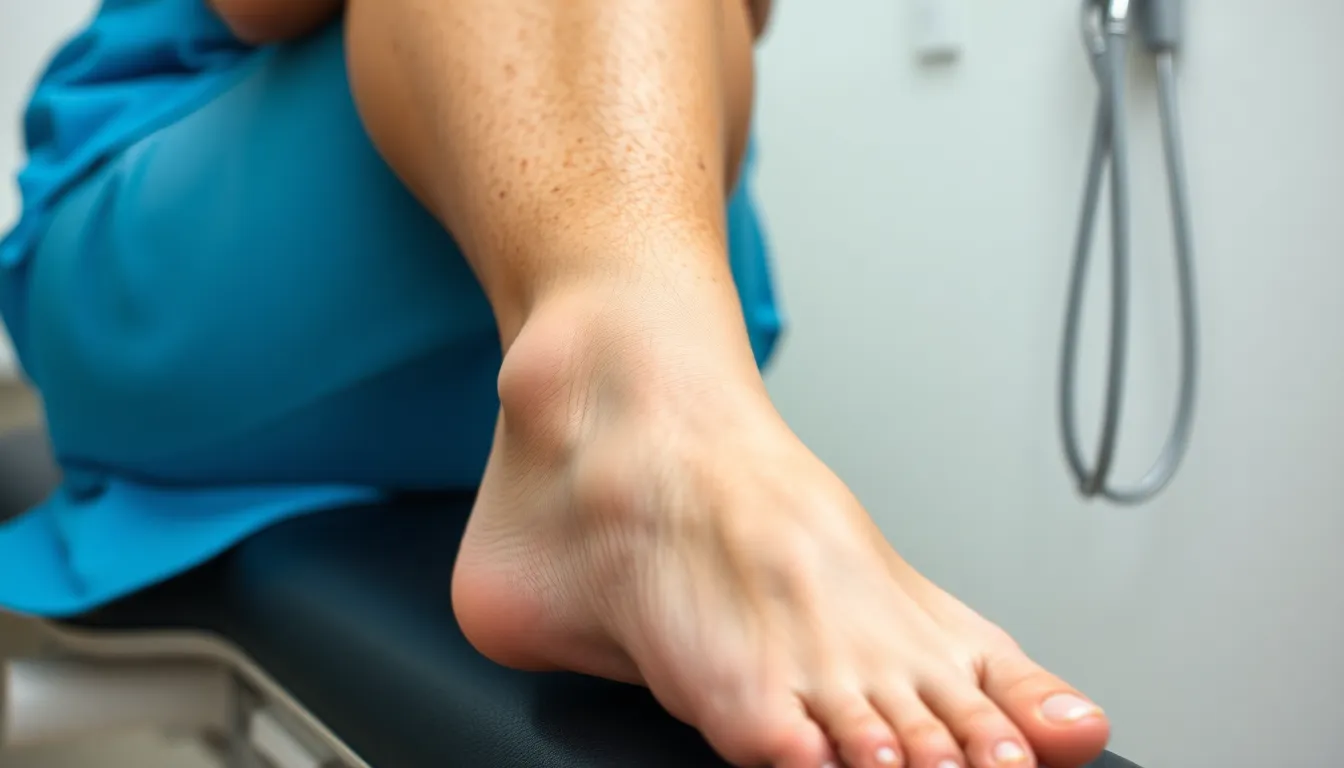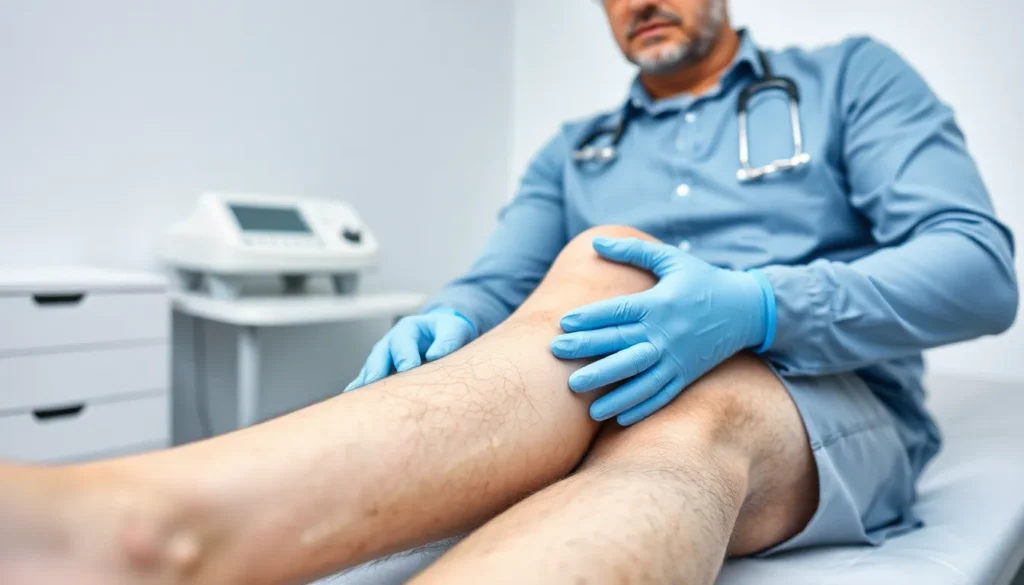Table of Contents
TogglePitting edema might sound like a fancy term for a new dance move, but it’s actually a medical condition that can leave anyone feeling a bit deflated. Imagine pressing your finger into a marshmallow and watching it leave a dent—that’s pitting edema in action. This condition can range from mild to severe, and understanding the pitting edema scale from 1 to 4 is key to tackling it head-on.
Understanding Pitting Edema Scale 1-4
Pitting edema is graded on a scale from 1 to 4 based on the depth and duration of the indentation formed when pressure is applied. Each grade reflects the severity of the condition, aiding in clinical assessment and management.
- Grade 1: This represents a mild edema. Indentations are barely detectable, typically measuring up to 2 mm. The indentation resolves quickly upon release of pressure.
- Grade 2: Moderate edema falls into this category. Indentations typically measure between 3 mm and 4 mm. Indentations remain visible for a short period, around 15 seconds after pressure is applied.
- Grade 3: This signifies a more severe form of edema. Indentations are deeper, typically measuring between 5 mm and 6 mm. The indentation persists for approximately 30 seconds.
- Grade 4: This is classified as severe edema. Indentations can reach depths of 7 mm or more. Residing for over 30 seconds after pressure is released, the indentation indicates significant fluid retention.
Recognizing the specific grade on the pitting edema scale is crucial for determining underlying causes and tailoring treatment options effectively. Clinicians will often evaluate the presence of any accompanying symptoms, which can provide additional insight into the patient’s overall condition. Monitoring changes in edema over time enhances patient outcomes by allowing for adjustments in treatment. Using the pitting edema scale as a reference offers a standardized approach to effectively address this common medical condition.
Characteristics of Each Edema Grade

Pitting edema ranges from mild to very severe, characterized by the depth and duration of indentations.
Grade 1: Mild Pitting Edema
Grade 1 in pitting edema presents with small indentations up to 2 mm. These indentations resolve quickly once pressure is removed, typically within a few seconds. Often, individuals may not even notice the swelling. It usually indicates mild fluid retention and may not signify any serious medical issues. Monitoring changes at this stage is essential to identify any progression.
Grade 2: Moderate Pitting Edema
Grade 2 features indentations measuring 3-4 mm that last approximately 15 seconds. In this instance, the fluid retention becomes more noticeable to both the individual and healthcare providers. Pain or discomfort might accompany this level, suggesting potential underlying health concerns. Regular assessment can aid in evaluating contributing factors, such as medication side effects or dietary influences.
Grade 3: Severe Pitting Edema
Grade 3 presents indentations of 5-6 mm, persisting for around 30 seconds. Individuals frequently experience significant swelling, making it uncomfortable for daily activities. At this stage, an underlying condition often contributes to the edema, requiring further medical evaluation. Prompt interventions can help identify the cause and manage symptoms more effectively.
Grade 4: Very Severe Pitting Edema
Grade 4 consists of indentations measuring 7 mm or more that linger for over 30 seconds. This level indicates serious fluid retention and can impact mobility and overall quality of life. Patients might experience pain, and there may be an urgent need for medical attention. Identifying the underlying cause is crucial for treatment and long-term management of the condition.
Causes of Pitting Edema
Pitting edema originates from various underlying factors. Understanding these causes aids in effective treatment.
Common Medical Conditions
Heart failure often leads to fluid retention, resulting in pitting edema. Kidney disorders can impair fluid regulation, contributing significantly to this condition. Liver issues, such as cirrhosis, may also cause abnormal fluid accumulation in the body. Additionally, venous insufficiency affects blood flow and can increase edema severity. Each condition demands attention to address potential health risks.
Factors Contributing to Edema Severity
Diet plays a role in edema severity, particularly high sodium intake causing fluid retention. Medications such as nonsteroidal anti-inflammatory drugs may also enhance the severity of edema. Physical inactivity contributes to poor circulation, worsening the condition over time. Hormonal changes, especially during pregnancy or menstruation, can exacerbate pitting edema. Environmental factors such as heat lead to increased swelling as well. Each aspect influences edema’s overall impact on individuals.
Diagnosis and Evaluation Techniques
Diagnosis of pitting edema involves a combination of physical examination and diagnostic imaging to identify underlying causes. Professionals assess the severity level through careful observation and testing.
Physical Examination
During a physical examination, practitioners evaluate the patient’s medical history alongside the present condition. They apply pressure to the skin to check for pitting and assess its grade on the scale from 1 to 4. Observations related to swelling distribution across limbs aid in identifying potential causes. Measurements of limb circumference often assist in determining the extent of edema. Palpation may reveal additional signs of fluid accumulation or tissue changes, providing crucial assessment data.
Diagnostic Imaging
Diagnostic imaging techniques play a vital role in evaluating pitting edema. Ultrasound serves as a preferred method that accurately visualizes soft tissue structures and detects fluid collections. X-rays can be utilized when assessing underlying skeletal issues contributing to edema. In certain cases, MRI offers additional insight into vascular or muscular conditions related to swelling. These imaging methods complement the physical examination, forming a comprehensive strategy for diagnosing the condition.
Treatment Options for Pitting Edema
Effective treatment of pitting edema involves various strategies tailored to the severity and underlying causes of the condition.
Lifestyle Modifications
Making certain lifestyle changes can significantly reduce pitting edema. Reducing sodium intake limits fluid retention, while regular exercise improves circulation. Elevating the legs during rest helps decrease swelling in lower extremities. Staying hydrated prevents further fluid accumulation, and maintaining a healthy weight reduces pressure on the body’s vessels. Compression stockings may also provide support by promoting better venous return. Each of these modifications can contribute to overall improvement, particularly for individuals with milder grades of edema.
Medical Interventions
For more severe cases of pitting edema, medical interventions often become necessary. Diuretics are frequently prescribed to remove excess fluid from the body. Adjusting medications may also alleviate symptoms in individuals whose edema is medication-related. Further evaluation might be required to address underlying health issues, such as heart or kidney problems. Physicians may recommend specific treatments based on diagnostic findings to improve the patient’s condition. Close monitoring of progress helps determine the effectiveness of prescribed interventions.
Understanding the pitting edema scale is vital for recognizing the severity of this condition. Each grade provides insight into the underlying issues that may require attention. Early detection and proper assessment can significantly impact treatment outcomes.
Monitoring changes in edema and addressing contributing factors can lead to effective management strategies. Whether through lifestyle adjustments or medical interventions, tailored approaches ensure patients receive the care they need. Awareness of pitting edema helps individuals take proactive steps toward better health and improved quality of life.







